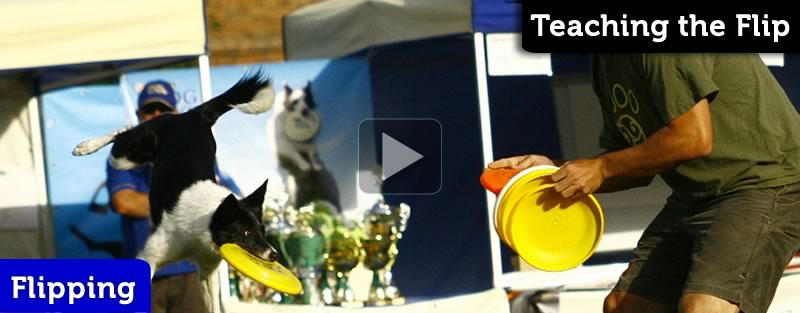
Teaching a Flip to a Disc Dog
Throwing at 10 o clock
In the video with Juicy, I’m not throwing at 10 o clock, and that’s because that’s not Juicy’s spot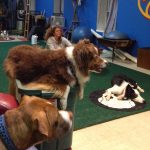 Spot is a “go to a place”, or “go to a mat” behavior. This means that the dog seeks out and performs a duration behavior on a spot of the handler’s choosing. A... More. It’s a poor illustration of the angle that we’re really looking for. It should have been about 1 foot further to the left of the screen. You should notice that the orientation of the rim was set in a fashion that allowed juicy purchase on the rim.
Spot is a “go to a place”, or “go to a mat” behavior. This means that the dog seeks out and performs a duration behavior on a spot of the handler’s choosing. A... More. It’s a poor illustration of the angle that we’re really looking for. It should have been about 1 foot further to the left of the screen. You should notice that the orientation of the rim was set in a fashion that allowed juicy purchase on the rim.
Check out Basic Flipping Principles
Trajectory
Dropping from High to Low creates a situation where the dog has to make a very quick decision. This is especially helpful for those of us who have dogs that are too quick (or too smart) to need to make the leaping flip. We essentially force them into flinging themselves for the target by reducing the amount of time they have to plan and prepare to strike the disc. This can be quite helpful for Border Collies that turn away and then make the catch in particular.
Throwing from Low to High is a much slower movement and asks the dog to watch the disc closely. Starting low keeps the dog’s head down, looking at the disc. As the disc starts to track upward, the dog keeps their eyes on the prize and the dog’s front end starts to come off the ground because of their focus on the disc. The flipping motion is started with the dog’s desire to keep their eyes on the target.
Flat Spin
For dogs with lower drive, that are too fast, or otherwise are not catching on to the flipping concept, we’re going to lower that disc out to 90 degrees (the C position from Flipping Principles) and essentially throw it where the dog has no chance of catching it without flinging their bodies. This Flat Spin will encourage the dog to be very aggressive as they’re fairly used to going hard after discs in that plane of movement. As the dog starts to let go and drive hard for the target we can start to raise the disc up to a more vertical orientation.
Using a Take
On many dogs, we can use a take, being sure to present the take behind the dog. We’ll push the disc out quickly and give our bite cue after the target has gotten behind the dog, pretty much over the dog’s rear end. We’ll let the dog take the disc out of our hand and complete the flip.
Notice the terrible landing that Hops had in the video due to me placing the disc in front of his head. Getting the disc behind the dog is critical for safety when using this technique.
The take should not be used too often or the dog will believe that they only flip for a disc in the handler’s hand. As soon as we’re getting a flip with the take, we’ll start to toss the disc to the same spot and give the bite cue. If the dog doesn’t go after the disc at the time of the bite cue, we might want to use the Flat Spin technique to bump up their confidence and get them thinking of popping on that target.



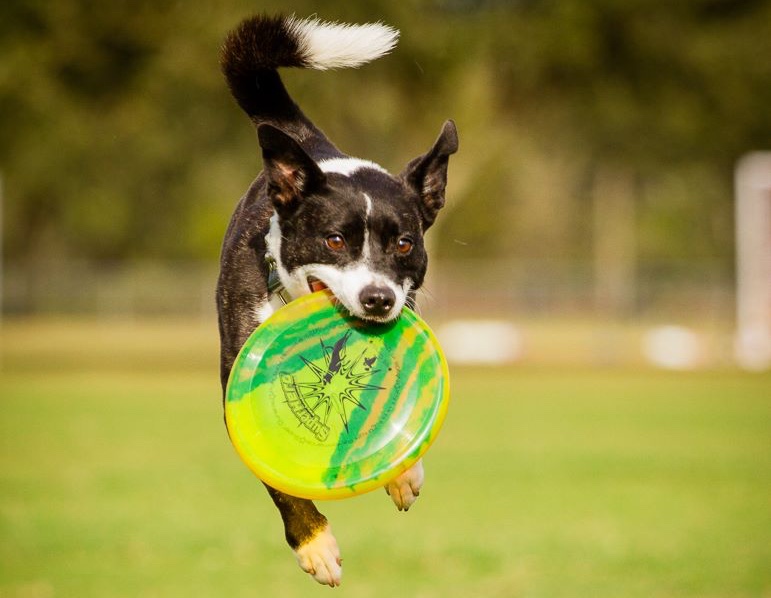

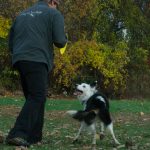
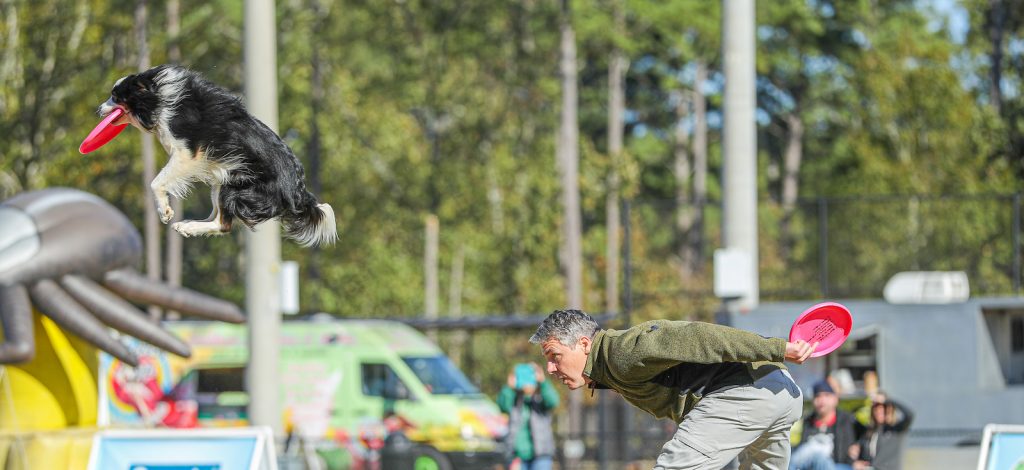
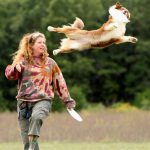
Groovy only sort of flips up till this point but tonight I tried the take method of teaching her and that got her to do to a “real” looking flip. I tried a few reps like that – all successful – then tried to do a throw that mimicked that but she reverted back. We’ll keep working on it though and when Jack gets back in town I’ll have him video if we are still struggling with this one.
Alright, Kat!
Be careful that she doesn’t learn that you’re going to hold it there… that can be frustrating trying to fix that.
One thing you can do is to try to put the toss into the mix of things when she is very high. Get her flying around then replicate the placement on the ‘Take It’ flip with a toss when she’s already flying around.
Are you giving the ‘Take It’ it a verbal bite cue?
I am giving the verbal cue for the take. Should I be for the toss too? I can’t remember if I did or not.
Hopefully she just needs to learn that her long semi truck body can actually do this move and it’ll progress from there! 🙂 I’ll be careful not to get stuck on the take though. Well and of course Jack gets back in town Wednesday night so she reverts back to being his dog then! 🙂 Just figured working flips with her was better than trying to teach Tali at this age and Spice is too young (though she already has shown us she is quite capable of flipping even when we don’t “ask” her to).
Hi Ron
Here is part one “Flipping” My video for this week. Please be kind! I like to know about my trajectory and help with the middle discs, the ones that Brodie miss or does not bite.
http://www.blip.tv/file/4512163/
Jeff
Alright, Jeff.
Good stuff.
That was a lot of flips though. Limit your repetitions. I know it’s going to happen at times, a session with lots of reps. But make those heavy repetition sessions the exception and not the rule.
Add Some Bite
I think I saw something interesting in your and Brodie’s flipping style. It seems to me that Brodie is really sitting back and waiting. It makes me think that maybe he’s playing the ‘throw it past me’ game.
It’s nothing bad or anything… it looks just like a lot of border collie flips we see and work with. It just struck me that we might be able to change it a bit by adding some biting to the mix.
You might want to do some bitework while working your flips to get Brodie nice and high. That will also get him whaling on the target. Driving towards it! Taking it!
You can give him a bite or two and reinforce the drop with a flip toss. Once he’s working hard, biting and dropping, and the flip toss becomes a reward he’s liable to go after it with a pop, because that’s what the game is.
Make the game an opportunity to get to catch the disc and ensure that he’s high and lively while playing the game, and you should see some performance increase.
Setting the Flip
Your setting of the flip off to the side like that is fine. As long as you can replicate the position easily. It looks as if the setup is based upon your straight leg position with a disc cue towards the foot. You could firm that up and make it a position.
Yachi Hirai, one of my favorite players, uses a very similar cue with his knee and the disc to set a bunch of his frontal positions.
You could make this a serious position by giving the cue, marking the moment he gets into position, and then reinforcing with a bite or a flip. You can increase duration by waiting to mark and reinforce until he has been in position for a moment or two. Then you can extend the time the dog is in position by waiting longer to mark.
Higher and Higher
Your tosses are a bit too low here, Jeff.
I understand why, he’s not very aggressive athletically. Not very committed. It’s a tough balance. Get him a bit higher in terms of his drive then place the discs a bit higher.
I think the reason that he’s taking the flips for granted. He kind of has to do them. Try to mark his set up position and reinforce with a flip or a bite.
peace
Here’s our video Ron… a few flips with Jack and a few with me. We don’t have birds in the background – just screeching dogs and the neighbors shooting guns! http://www.youtube.com/watch?v=JSabqntSGdY
Interestingly enough just yesterday she started doing those real nice flips (to her right I think) for Jack. I swear it was after she watched Jack and I do flips with my mom’s dog Max (the one I worked with at the seminar down here). They were pretty good before but now have a little added flair.
That’s looking good guys.
Was that a gunshot during that session?
I think Through… Wait… Flip would be a good thing for you to work Kat… If you mark the Wait and reinforce with a flip toss she’s liable to really go after those discs. It will also help to keep her high and engaged.
You and Jack both need to get those discs to hover a bit more on those flip tosses. Think Donna Schoech… Not easy, but Groovy needs a sharper target than you are giving her with those lofty flip tosses. Put those discs in a spot.
Make sense?
Makes sense – whether or not we can do that is another story but it makes sense! We’ll work on that.
Yes – that’s a gunshot – the neighbors thought it was a good day for target practice. She was a little concerned hence the go around to the out toss to keep her brain in gear but she did great with it overall considering her fear issues in general. And the other thing you are seeing is how Groovy isn’t near as into the game with me if her daddy is present. If he isn’t there she is a maniac with me like she is with him but if he is there and discs are around I’m next to invisible! 🙂
Ron – Chance doesn’t quite get the flip for a disc concept yet. However, when I toss a shovel full of snow over his head, he flips quite nicely. Does that count? We were having so much fun with that, I had to remind myself to limit the reps!
😉
Flipping and butterflies I see in this video if I get the throw right he will do it, wouldn’t at all last class, but we’ve been trying, and getting there.
http://www.youtube.com/watch?v=fQ6K_p1h9bc
I notice the Bent Cavaletti apparatus is still there. How much time between that session and this one?
@0:18-0:37
That’s a nice butterfly sequence. A bit too rushed on calling the drop. Let the catch happen and a second of holding then call the drop. I do this all the time, Bob, in my rush to get the next one going.
This is a multiple sequence. If you want it to score well, all you would have to do is to bump up the frequency a bit (less time in between throws) and take a step back after each throw. This will create a little action and movement.
Notice that with this multiple sequence that you’re getting a real nice drop on cue. Love the title of the video, by the way. It shows that you are conscious of the multitasking going on here.
@0:40
Nice flip. A bit late on the mark for the catch, it sounds like, but the flip is real nice. I particularly like the prediction of the drop @0:52 – that is really nice – looks like you held back for a moment and then gave the cue at a better time when he was more likely to drop – good work!
All of your flips are a little too low. A dog like Scout is about as tall as your waist when standing on hind legs. The flip must be thrown higher than your waist so as to require the dog to leap off the ground.
Also on your flip, you can multitask here – working flip and drop… It doesn’t look like Scout has any problems catching the flip. So instead of marking the catch try marking the Flip. When he gives you good effort on the flip, mark it, if he kind of half asses the flip, don’t mark it.
If you want to isolate and improve the flip, the marking of the flip could be reinforced with a roller or a throw. But because you are working both the flip and the drop, what you did in the video looks appropriate.
@1:08
Definitely his weak side here. You might want to try your left hand for the flip toss to see if you can get that working. The inverted right handed toss works, but a left hander for a flip is really easy.
Go Do Dog Stuff!
Great job dismissing him! This is a great session length for you and Scout. Remember you want to dismiss him when he’s on high and before he starts to be sticky on that drop. In close work, I’m not sure how long that is, but when he’s running around, it’s about 45 seconds or so. Avoid the problem behavior.
Dismissal to Avoid the Sticky Drop
If you get 3 drops on the run in your first 20 seconds… “Go Do Dog Stuff!” quit on high and take a break. That will leave Scout with the experience of only dropping on the run and will leave him fresh and excited to do it again.
Good job, Bob!
Here’s a video to all three of my dogs flipping. Interestingly, the non-flipping dog (Eda) really seems to have had a breakthrough after I read about your suggestion to try throwing with the off hand. Migo is just starting off with flips, I’d really like to have good flips with him, it would make our life os much easier 🙂
http://www.youtube.com/watch?v=tAwu0naGQCA
Oma
Notice the difference between the early flips and the flip @0:21. The flip @0:21 looks very strong. There are two points that are different between them.
The flips before @0:21 Oma is in oriented similar to Front Position. @0:21, she’s kind of perpendicular to you. You should be able to get this flip out of any position where she’s perpendicular to you facing to your right.
Try a rear cross that puts her in that position and before she has finished the skill, deliver that throw. I think you’ll find that you have quite a strong flip with a really clever and fluid set up. That will flow!
The placement @0:21 is further away from her center. Remember that. She needs to step forward and collect a bit before she flips which is why that little off centered angle @0:21 worked for her. It’s very hard to collect from front position when the target is going to be placed behind you.
@0:21 is a Gainer Flip. She’s moving forwards and flipping backwards. You might be able to accomplish this from Front Position if you give her some space or step back (probably step back) to allow that collection. You will have to deliver the disc to the same general area and in the same fashion that you did on the @0:21 mark, only switch the angle. I hope you can understand that. I could totally show you, but I think trying to explain it further would really complicate the issue. I’ll just say that you’re not going to throw it behind her. It will probably be .2-.3M in front of her face. You must be careful that she is prepared for this and you hover it well, as @0:21 or you could have a crash.
Nice reinforcement @0:38. Notice that the successful flips all kind of replicate that off centered Front Position.
@0:51-@1:00 – nice job. That’s an around teh world kind of a concept – or a flower pattern, as I used to call it with Tony Hoard, you can also do a Zig Zag kind of thing, using those gainer flips to do the Dosi-Do movement. That will give you 2 flipping multiples. Good for diversity and points.
Once again, great session length!
Migo
Same kind of set up. It’s a good flip.
Don’t send him around all the time. It will become a pattern that is necessary when flipping for both you and the dog. Work straight in to a proper Front (not from the go around all the time) and allow him to drift to the starting position (by stepping back and setting your flipping position) or teach a crooked or fluid Front position that sets up quickly on the right angle. Hope that makes sense…
@1:59 – Way to give yourself a “Yes!”. You deserve it! 🙂
Back to Front Through
Work with Takes, for a really long time, before you start to throw. You and the dog both need to establish comfort with timing and placement – it needs to be a pattern – before you start to introduce the random placement and timing of the thrown disc. You guys need muscle memory and understanding of the skill before you start throwing. This is a HUGE mistake people make – trying to run before they can walk. Learn first then perform.
@2:36, you see the result of that randomness. I will be surprised if his effort is as strong on the next one… let’s see… Looks like he did a good job, but it’s not helping him in terms of confidence. Takes, until they are perfect!
By using takes you can also increase the height (yours is quite low right now young dog, not much practice – understandable) and learn what placement and timing yields the strongest and safest results. Then all you have to do is make your placement and timing fit that pattern – which is easy to do because you have felt how it works.
The vocalizing is not bad. He’s not in any danger of being poorly reinforced it doesn’t seem inconsequent to me… that’s part of the game that’s part of the fun – it’s part of your relationship.
Eda
How does it look standing up? Have you tried vertical tosses? @3:45 looked good – vertical seems better to me. They are a little low as well which is to be expected as neither of you believe she can flip. 😉
OK… @ 4:10 you are using the same hand placement for a different side flip. Try to throw a non-inverted backhand with your left hand for a flip to your left, and a non-inverted backhand with your right hand for the right flip. You are only switching the flip direction by the dog and not the release from the handler. Hope that makes sense. I think it will also make a big deal.
It also helps you to deliver the disc from really low, which seems to be what she favors. Right now you can only get so low, and to do so you must squat down. You are limited by having to have your elbow below your hand. The only way you could get lower is by lying down yourself.
If you use the right hand for the flip to your right, you can bend at the waist and touch the disc to the ground if you’d like to. It will also be a more natural release for you enabling you to deliver discs more simply.
I think you did too many repetitions of flips with Eda. Be careful of working weak tricks to exhaustion. It hurts more than it helps.
Zig Zag for Big Leaping
Awesome!!! That’s what I’m talking about. Over and over and over… can’t go wrong with that kind of practice. When you stick fancy throws in there, the expectation will be to leap. Then all you have to do is to get close.
Great job Setting the Flank! Yay! Now do that on your regular flatwork and deliver discs for big leaping off that pacing moment.
Great Job!!!